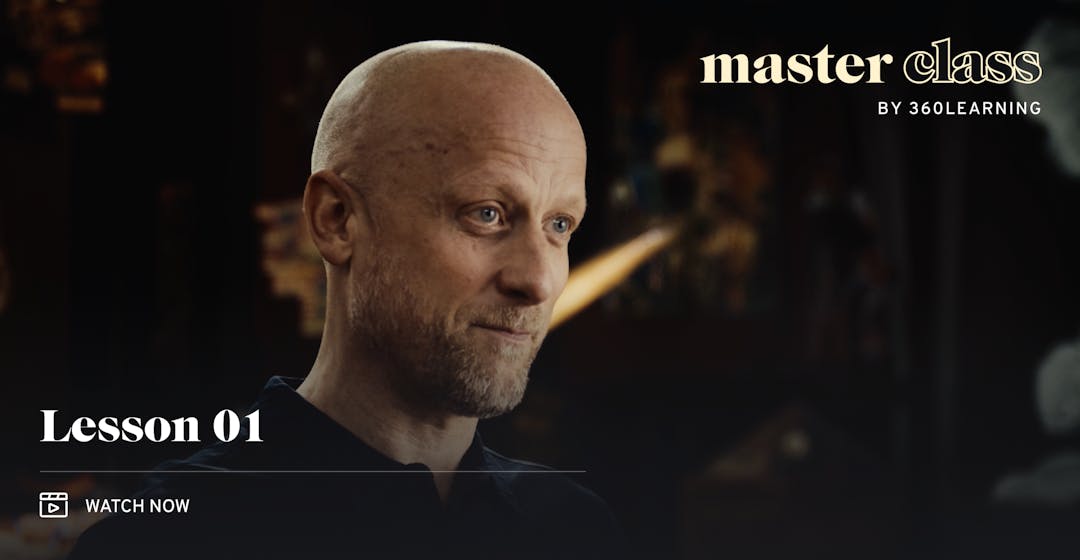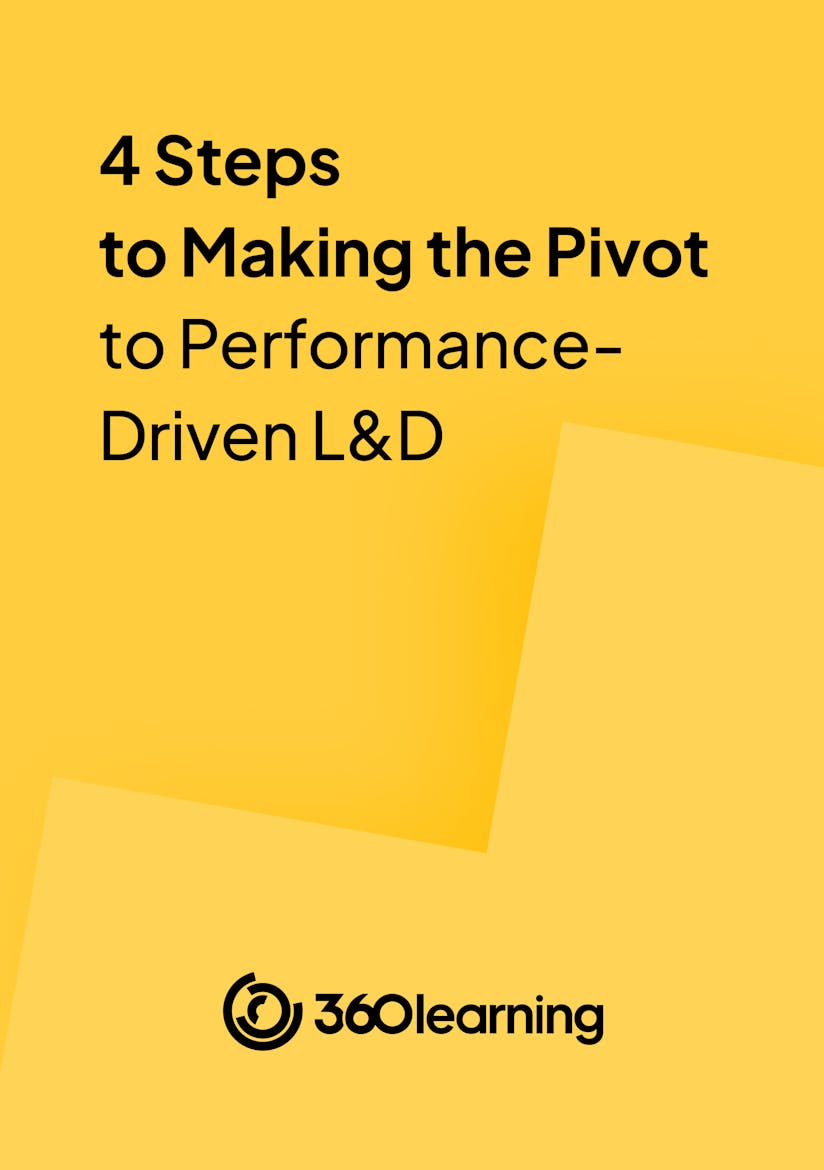
L&D Master Class Lesson 1: Get Started with Impactful Digital-First Learning in 3 Key Steps
As L&D leaders, making the transition to digital-first learning can seem bewildering.
How can you start tracking the real business impact of your learning content? What about your learners who might be used to traditional classroom learning? And how can you make sense of the vast market of tools all promising L&D nirvana?
In the first lesson of our L&D master class, David James unpacks his three key steps to getting started with digital-first L&D, and explains why every great learning strategy starts with understanding the real problems that you're trying to solve.
Missed the introduction to our L&D master class? Check it out here!
Digital-first L&D can seem scary–so where should you start?
*This content is provided by 360learning, an independent company, with no affiliation with the “MasterClass” brand.
1. Recognize that your goal isn’t more engagement–it’s greater impact
Today, many L&D leaders are focused on chasing one thing above all else: more learner engagement. But no matter how many course completions or learning hours you achieve, you’re missing the point if you can’t demonstrate your impact.
“Since the 1990s, there have been more and more silver bullets each year that are going to change the way that learning and development will operate and also the impact that it has,” says David. “But this is missing the point.”
As David notes, the market for digital learning solutions is huge and it's getting bigger. When he started out in learning and development, he can still remember that eLearning was going to replace classrooms.
“We're sold promises that this technology is going to change L&D, but the only problem is that it doesn't, because we're not really solving real problems. The only problem that we seem to be solving is the lack of engagement in learning and development.”
But the real problem we’re here to solve is the reason learners want to engage in the first place–they want to do their job better and faster, develop new skills, and improve their prospects. That’s why L&D leaders need to drive greater impact rather than focusing solely on getting more engagement.
“And what the organization requires as well,” says David, “is that people are ready or improving on their transitions into an organization, and that they’re getting better at doing the job themselves.”
And according to David, that means L&D leaders need to start by defining real problems.
We're sold promises that this technology is going to change L&D, but the only problem is that it doesn't, because we're not really solving real problems.
Looking for some tips on pivoting to performance-driven L&D? Check out our four-step playbook for achieving more impactful L&D.

Impactful, demonstrable L&D in 4 simple steps
By providing your contact info, you agree to receive communications from 360Learning. You can opt-out at any time. For details, refer to our Privacy Policy.
2. Define the real problems you want to address
In David’s experience, every great learning strategy starts with understanding the real problems that you're trying to solve.
“When we're intent on looking at the solutions before we understand the problems, it seems insurmountable,” he explains. “Technology seems to move in so fast, especially in learning and development, that it does seem difficult to keep up.”
But as David says, we’ll never catch up. If we just focus on the solutions and where those are going, then we will lose sight of what we’re in organizations to do.
“We're in our organizations to help the people we’re expected to influence, and to help improve the work that they're doing,” says David. “We’re there to help our leaders and organization prepare people to do those jobs, and to transition and to adapt when that's expected.”
As David explains, if we focus on the problems rather than where the technology is going, we can see exactly where we need to apply our attention, our budget, and the reputational credit we have in our organizations.
“One of the biggest risks is,” says David, “every time we release a silver bullet telling our audience that this is going to transform them, we lose credibility because it's not going to transform them. The only thing that it really transforms is our budget, because it lessens.”
So, now that you’ve defined the problems you’re trying to solve, how can you focus on driving the right learning outcomes?
Every time we release a silver bullet telling our audience that this is going to transform them, we lose credibility because it's not going to transform them. The only thing that it really transforms is our budget, because it lessens.
3. Shift the conversation to focus on impact, not tools
When it comes to shifting the conversation to focus on outcomes, David has some good news and some bad news.
The bad news? David explains that there isn't a single platform or suite of content, regardless of how exhaustive it is, that's going to answer all the problems facing L&D.
“But the good news is,” he says, “the solution does lie with us. If we do the analysis and we understand what it is that people really need our help with, then the solutions out there don't seem so vast because we're not looking at the entire market.”
By analyzing those needs, we can turn our attention to the tools that will really help us achieve our goals. And David has some more good news: some of these tools will be free and available within our organizations.
“We should be looking internally at what our employees and our teams are trying to do, and then looking for the most efficient and effective ways that we can affect them and help them to do what they're trying to do,” David says.
Get started by having a different type of conversation. Instead of responding to requests for training, eLearning, or a specific platform, extend the conversation to what it is you’re trying to achieve. Who is it specifically that we're trying to influence?
From here, says David, we can look at the tools immediately available to us, and we can start running experiments immediately.
“Yeah, we might need some more tools afterwards,” David explains, “that might help us to automate or present content in a different way or integrate the tools that people already use. But to start, we can run experiments simply in response to a different type of conversation.”
Stay tuned for next week’s lesson on how to help learners thrive during moments of transition and adaptation! You can get all lessons delivered straight to your inbox by signing up for our weekly content newsletter below.
If we do the analysis and we understand what it is that people really need our help with, then the solutions out there don't seem so vast because we're not looking at the entire market.
Looking for more great resources on transformative learning?
If you loved this L&D master class, be sure to join The L&D Collective, our community of learning leaders where David hosts quarterly AMAs (Ask Me Anything) on everything related to impactful L&D.
And for more practical guidance, check out the 360Learning Resources Hub. Here, you’ll find a range of ebooks, cheatsheets, and articles on everything from onboarding to blended learning and more.
Thanks for watching!


